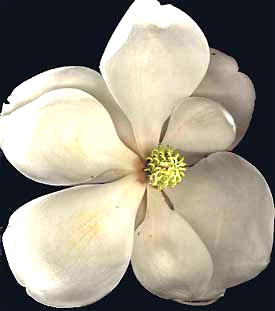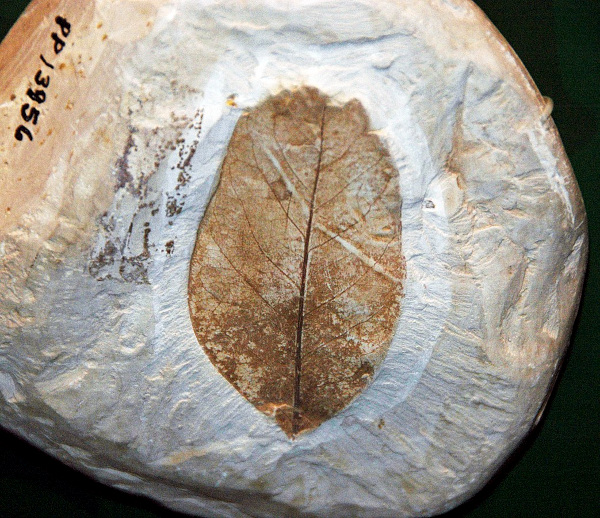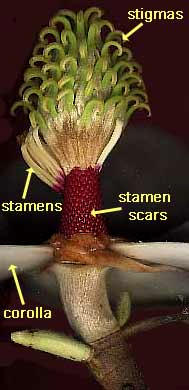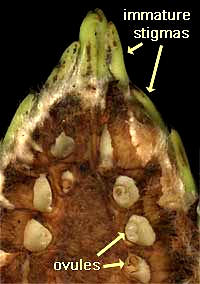
The blossom at the right, from a Southern Magnolia, Magnolia grandiflora is about 8 inches across (20 cm). As the flower was being photographed, the air all around it was suffused with a powerful, lemony, even "romantic" fragrance. Magnolia flowers are wonderful!
Magnolia blossoms grow at the end of a tree's branches. The flowers bear 9-15 big, white petal-like things technically called tepals instead of petals. The term tepal is used when the calyx with its sepals, and the corolla with its petals, are indistinguishable. In magnolia flowers, sepals look just like the petals.
 Fossil magnolia leaf in Cretaceous rock from Alabama, USA; image courtesy of James St. John and Wikimedia Commons
Fossil magnolia leaf in Cretaceous rock from Alabama, USA; image courtesy of James St. John and Wikimedia CommonsPeople who study the evolution of flowering plants say that magnolia flowers are similar to some of the very first flowers. They're not the most primitive surviving flower type (waterlilies are often thought to be more primitive), but they're certainly of an ancient lineage. Magnolia Family fossils have been found dating to the Cretaceous Period, about 60 million years ago. Such a Cretaceous fossil, of Magnolia boulayana, appears at the left. These fossil trees lived before bees evolved, so it's theorized that the earliest forms evolved to encourage pollination by beetles.

Among magnolia blossoms' primitive features are the facts that, in contrast to our Standard Blossom, they bear many stamens and many pistils. Stamens are arranged in spiraling rows, and both stamens and pistils are attached to a fingerlike receptacle. Magnolia pistils mature into follicle-type fruits, follicles being dry fruits that derive from a single ovary compartment, or carpel, opening along one side to release its seed. The magnolia's tightly clustering follicles form a cone-like structure, a "syncarp," which is a kind of aggregate fruit. Blackberries are another kind of aggregate fruit, but they're fleshy, while the magnolia's are dry.
Magnolia follicles and fruits also are fairly tough and hard. It's speculated that this condition evolved in response to the flowers' pollinating beetles who may have otherwise eaten the pistils as they pollinated.

The picture at the left shows an immature magnolia flower while it was still a flower bud, cut down the middle. The whole thing is about as wide as your finger is thick. Notice the pistils' ovules, which will mature into seeds. The ovules look like tiny eggs inside pale compartments. Each magnolia pistil bears just one fingerlike stigma and one carpel, and each carpel contains only one or two ovules. Less primitive flowers typically have branched stigmas and more than one carpel per pistil.

At the right you see a mature magnolia fruit with red seeds dangling from the fruit's many split-open follicles. Atop each follicle you can see the dark, dried-up remains of the stigma. Wild birds, squirrels and other animals eat the seeds, which can be guessed anytime large red seeds are seen dangling in the open. But eaten seeds don't grow into new magnolias. Squirrels store and then forget some of their seeds and maybe birds drop a seed here and there. Wind and rain also moves the seeds around. But all this sounds very iffy. In fact, this may explain why about half of the world's magnolia species are threatened with extinction.